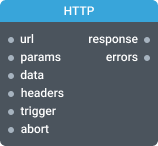HTTP
Makes HTTP requests to external APIs and web services with secure credential handling.

In-ports
url String — Target URL for the HTTP request.
params Object — URL parameters for path replacement and query strings.
data <any> — Request body data for POST, PUT, and PATCH methods.
headers Object — Custom HTTP headers to include in the request.
trigger <any> — Triggers request execution. If not connected, requests fire on URL changes.
abort <any> — Cancels all pending requests immediately.
Out-ports
response Object — HTTP response data or error signal.
errors Object — Error details when requests fail.
Overview
The HTTP connector sends secure requests to external APIs through Kelp's Data Gateway. All requests are proxied through the backend service to protect credentials and handle CORS restrictions.
Quick Start:
- Connect a URL to the url port
- Optionally add authentication in Settings
- Connect response port to handle results
Params
The params port values are appended as query parameters in the URL by default. This port accepts parameters as either an array or object. By enabling the "Path parameters" setting, you can include parameter placeholders in both the path and query parts of the URL. The connector first replaces these placeholders with values from the params port, then appends any remaining values as query parameters. URL placeholder parameters are mandatory by default—use the * (zero or more) quantifier to make them optional. Learn more about how to use parameters in HTTP Request URLs.
Order of Invocation
A URL is required for the HTTP request—without an event on the url port, no request will be sent. You can provide additional optional attributes through the params, data, and headers ports.
When initialized, the HTTP connector waits for the first event on url port before triggering the request. After that, any event on any input port will trigger a new request.
If the trigger port is connected, the connector will wait to fire the request until an event is received on the trigger port. The connector will then fire the request every time an event is received on the trigger port. To control the order of updates on input ports and firing the request, you can use a Fork component in combination with the trigger port.
If any errors occur during the request execution, the corresponding error message will be emitted on the errors output port.
Authentication
Credentials are securely stored in Kelp's vault and injected at request time. No sensitive data is stored in your application or transmitted from the browser.
Settings
Integration Profile
Required to authenticate external API calls. Select a configured profile or add a new one.
Path parameter processing (urlProcessing)
Method for handling URL parameters. Learn more about HTTP Request Parameters.
- Required: No
- Values:
none,path-params - Default:
path-params
Request method (method)
HTTP method for the request.
- Required: Yes
- Values:
get,head,post,put,patch,delete - Default:
get
Response data type (responseType)
Expected response format.
- Required: No
- Values:
json,text,arraybuffer,blob - Default:
json
JSON — Parse as JSON object. The connector will output null if the result cannot be parsed as JSON.
Text — Return as string.
Array buffer — Binary data as an array of bytes. Refer to Array Buffer for more information. You can convert it into a base64 string using the KelpQL base64_encode function.
Blob — Binary data as blob object.
Timeout (timeout)
Request timeout in milliseconds.
- Required: No
- Default:
0(no timeout)
Include Origin header (includeOriginHeader)
Adds Origin header to request.
- Required: No
- Default:
false
Include Referer header (includeRefererHeader)
Adds Referer header to request.
- Required: No
- Default:
false
Keep always active
Determines whether the component will remain active even if it is not connected to a visible widget or another active component.
Common Errors
- Missing URL: Ensure the url port receives valid URL data.
- Authentication failures: Verify integration profile credentials are correct.
- Timeout errors: Increase timeout value or check service availability.